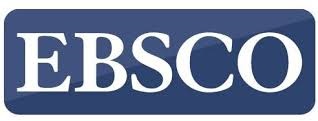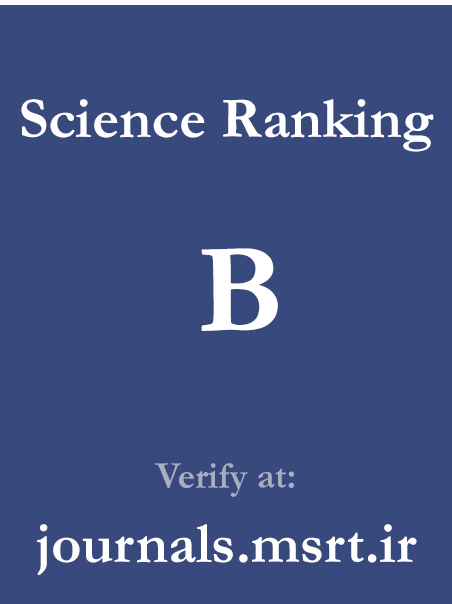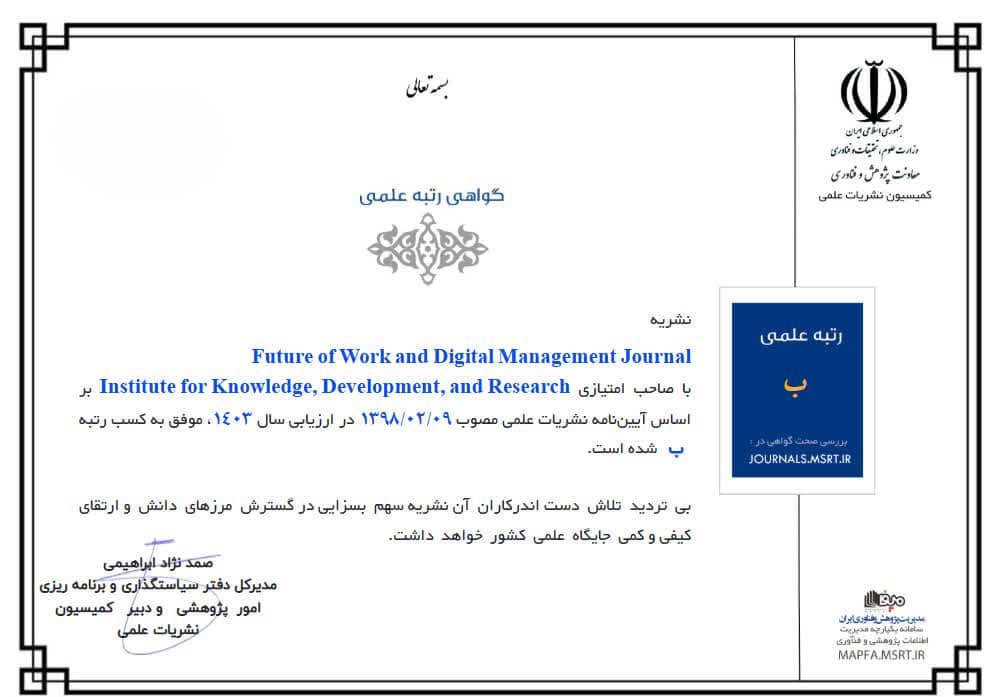Designing a Green Leadership Model in Digital-Age Organizations
Keywords:
digital green leadership, digital transformation, artificial intelligence in management, environmental digital literacy, green innovation, value-driven leadershipAbstract
The present study aimed to design a green leadership model for organizations in the digital age. This research was conducted within an interpretive paradigm and employed a qualitative approach, using the thematic analysis strategy to analyze the collected data. The statistical population consisted of experts from the National Nutrition and Food Technology Research Institute. Data were gathered through semi-structured interviews with 15 experts who were selected purposively. The inter-rater agreement was calculated using Cohen’s Kappa coefficient, which was 0.75. Based on the findings, three overarching themes and seven subthemes were identified. The overarching themes included value-driven green leadership (organizational green vision, ethics-oriented leadership style); digital green leadership (environmental digital literacy, green transformational leadership, green technological creativity); and green synergy (digital social responsibility, cross-sectoral environmental collaboration). The findings indicate that digital green leadership, as an integrative approach, plays a crucial role in addressing environmental and technological challenges faced by contemporary organizations. Leaders with technological insight and environmental commitment can leverage emerging technologies and reinforce ethical and cultural values to foster sustainable transformation, enhance organizational agility, and institutionalize a culture of responsibility in the workplace.
Downloads
References
[1] O. Boiral, "Environmental leadership and consciousness development: A case study among Canadian SMEs," Journal of business ethics, vol. 123, pp. 363-383, 2014, doi: 10.1007/s10551-013-1845-5.
[2] J. Crossman, "Environmental and spiritual leadership: Tracing the synergies from an organizational perspective," Journal of Business Ethics, vol. 103, pp. 553-565, 2011, doi: 10.1007/s10551-011-0880-3.
[3] Z. He, "Driving mechanism model of enterprise green strategy evolution under digital technology empowerment: A case study based on Zhejiang Enterprises," Business Strategy & the Environment, vol. 32, no. 1, pp. 408-429, 2023, doi: 10.1002/bse.3138.
[4] T. Y. Khaw, "The impact of digital leadership on sustainable performance: a systematic literature review," Journal of Management Development, vol. 41, no. 9/10, pp. 514-534, 2022, doi: 10.1108/JMD-03-2022-0070.
[5] M. A. Alabdali, "Unveiling green digital transformational leadership: Nexus between green digital culture, green digital mindset, and green digital transformation," Journal of Cleaner Production, vol. 450, p. 141670, 2024, doi: 10.1016/j.jclepro.2024.141670.
[6] H. Nurasa, P. S. S. Unyi, A. Abdillah, and I. Widianingsih, "Green Leadership in Policy Making towards Sustainable Future: Systematic Critical Review and Future Direction," Pol. J. Environ. Stud., vol. 34, no. 1, pp. 519-534, 2025, doi: 10.15244/pjoes/186576.
[7] S. Mittal, "Transformational leadership and employee creativity: Mediating role of creative self-efficacy and moderating role of knowledge sharing," Management Decision, vol. 53, no. 5, pp. 894-910, 2015, doi: 10.1108/MD-07-2014-0464.
[8] M. Mousavi, S. Moradi, and L. Sharifian, "Presenting a Transformational Leadership Style Model for Educational Managers," Bi-quarterly Journal of Adolescent and Youth Psychological Studies and News, vol. 2, no. 3, pp. 313-325, 2021, doi: 10.61838/kman.jayps.2.2.26.
[9] M. Farhadinezhad, S. Ali Karami, and M. Abdi, "Investigating the Impact of Green Transformational Leadership on Green Workplace Behaviors: The Mediating Role of Employees' Environmental Attitude," Journal of Transformation Management Research, vol. 11, no. 2, pp. 29-52, 2019.
[10] S. Umair, U. Waqas, B. Mrugalska, and I. Bystrov, "Linking transformational leadership to green human resource management (GHRM) and employee engagement in green initiatives," International Journal of Sustainable Engineering, vol. 17, no. 1, pp. 1083-1095, 2024, doi: 10.1080/19397038.2024.2434703.
[11] A. Amini, M. Alimohammadlou, and A. Ja'fari, "Presenting an Integrated Model of Effective Leadership in Technology Adoption," Journal of Management Process and Development, vol. 32, no. 4, pp. 153-188, 2019, doi: 10.29252/jmdp.32.4.153.
[12] A. Varma, "Artificial intelligence and people management: A critical assessment through the ethical lens," Human Resource Management Review, vol. 33, no. 1, p. 100923, 2023, doi: 10.1016/j.hrmr.2022.100923.
[13] A. Y. Aránega, "Towards an entrepreneurial leadership based on kindness in a digital age," Journal of Business Research, vol. 159, p. 113747, 2023, doi: 10.1016/j.jbusres.2023.113747.
[14] T. W. Chang, "How to shape the employees' organization sustainable green knowledge sharing: Cross-level effect of green organizational identity effect on green management behavior and performance of members," Sustainability, vol. 13, no. 2, p. 626, 2021, doi: 10.3390/su13020626.
[15] W. Zhao, "The impact of green transformational leadership, green HRM, green innovation and organizational support on the sustainable business performance: Evidence from China," Economic Research-Ekonomska Istraživanja, vol. 35, no. 1, pp. 6121-6141, 2022, doi: 10.1080/1331677X.2022.2047086.
[16] M. Mazaheri Tehrani, S. M. Alvani, R. Vaezi, S. S. Zahedi, and V. Ghorbanizadeh, "A Green Management Model for Iranian Governmental Organizations," Quarterly Journal of the Iranian Management Science Association, vol. 17, no. 68, pp. 1-43, 2022.
[17] S. Seyyed Alavi, H. Ghalavandi, M. Abbaspour Fard Tehrani, and K. Mohammadkhani, "Presenting a Model for Applying Green Management in Tehran Public Universities," Quarterly Journal of Research and Planning in Higher Education, vol. 26, no. 3, pp. 77-95, 2022.
[18] H. Zafar, J. H. Cheah, J. A. Ho, Y. Suseno, and F. Tian, "How green servant leadership influences organizational green performance? The roles of employee green creativity, voluntary pro-environmental behavior and green psychological climate," Personnel Review, vol. 54, no. 4, pp. 971-995, 2025, doi: 10.1108/PR-10-2023-0843.
[19] K. Kardoyo, "Influence of the green leadership toward environmental policies support," The Journal of Asian Finance, Economics and Business, vol. 7, no. 11, pp. 459-467, 2020, doi: 10.13106/jafeb.2020.vol7.no11.459.
[20] S. S. Zahedi, Comprehensive Sustainable Development with an Emphasis on Green Management and Entrepreneurship. Tehran: SAMT (Organization for Studying and Compiling University Humanities Books), 2016.
[21] M. Hajizadeh Farasoun, M. Jajarmi Zadeh, and A. Mohtashami, "Designing an Implementation Model for Green Human Resource Management in Iranian Governmental Organizations," Journal of Information Management Sciences and Technology, vol. 8, no. 2, pp. 73-114, 2022.
Downloads
Published
Submitted
Revised
Accepted
Issue
Section
License
Copyright (c) 2024 Masoomeh Arabzadeh, Marzieh Moradi Dalini, Houshang Taghizadeh (Author)

This work is licensed under a Creative Commons Attribution-NonCommercial 4.0 International License.








